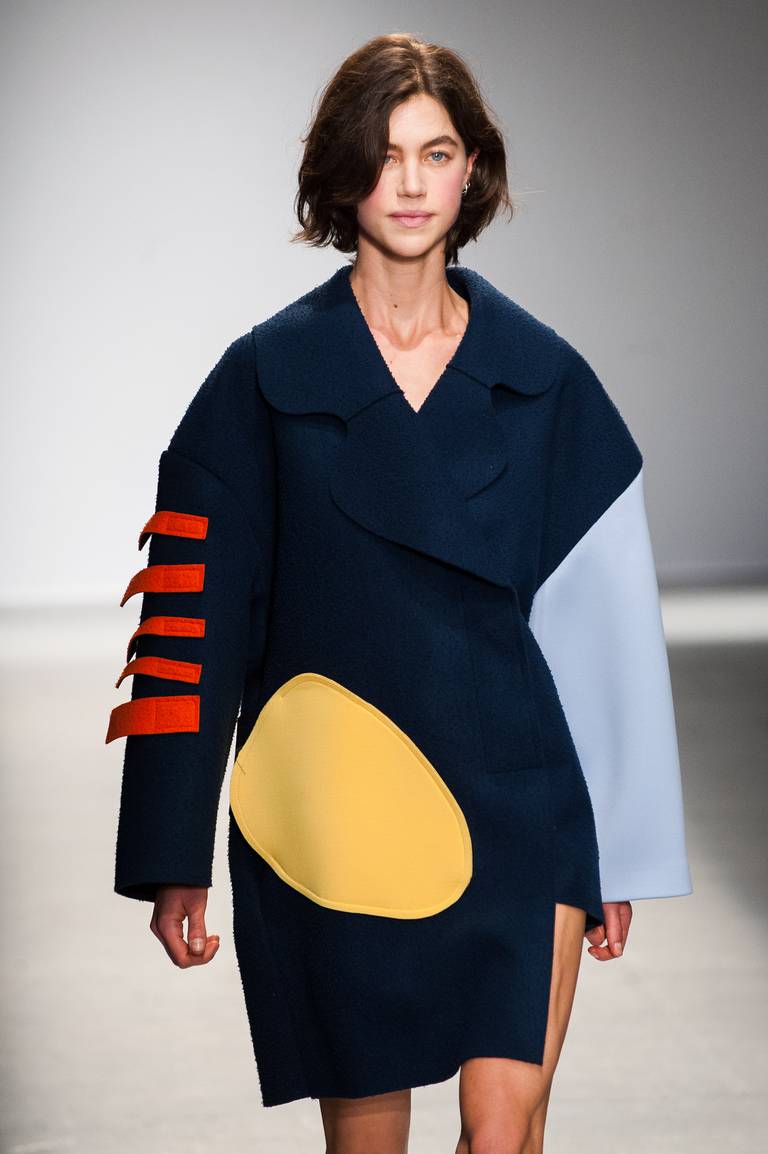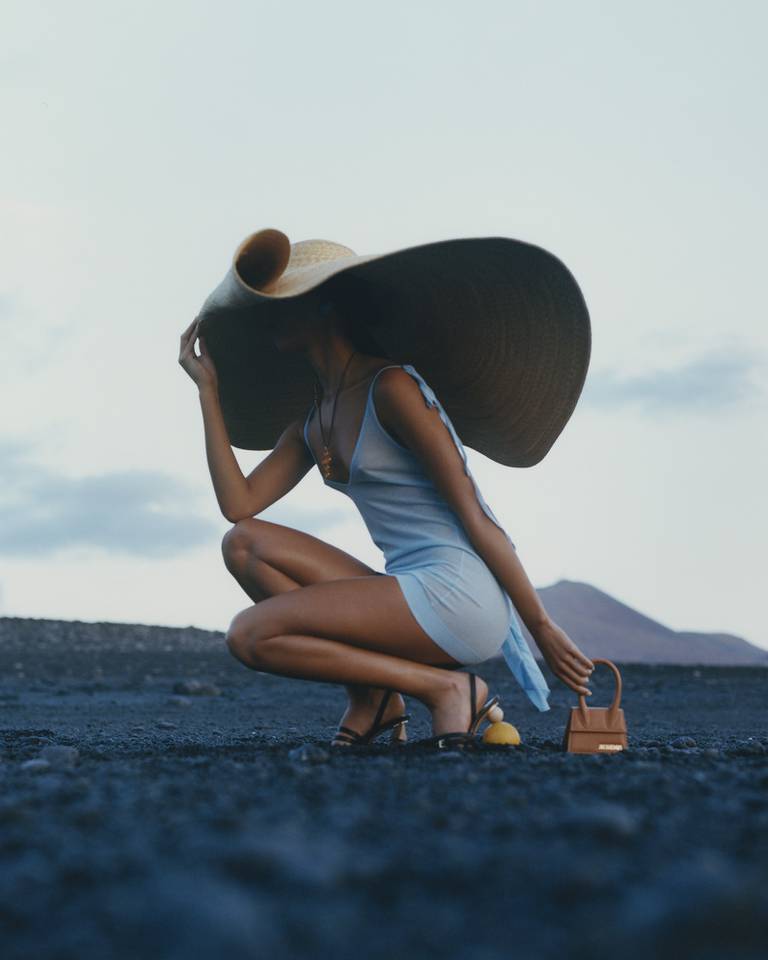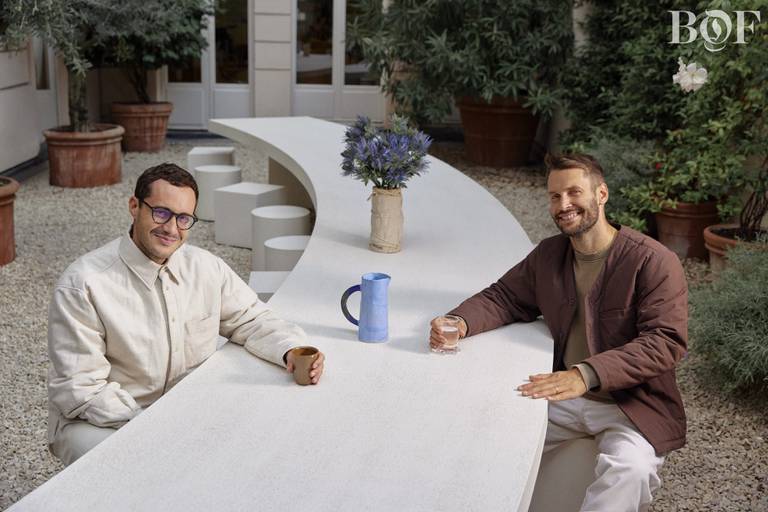
PARIS — In 2011, when Simon Porte Jacquemus — then a shaggy-haired fashion school dropout — needed to spark some buzz for his fledgling label, he dressed a group of girlfriends in his designs and crashed Vogue’s “Fashion Night Out” party on Paris’ Avenue Montaigne. The group staged a mock protest, brandishing cardboard signs and chanting “We Want Jacquemus!,” wearing a collection of boiled wool sweaters and skirts that would have looked more at home in a New Wave kitchen scene than on a high-glamour shopping street lined with Dior and Chanel boutiques.
The light-hearted guerilla stunt landed the 21 year-old designer on television, as well as a place in France’s public consciousness, where he would soon become as much a household name (at least among young people) as fashion icons like Jean-Paul Gaultier, Pierre Cardin or his hero Christian Lacroix.
Twelve years later, during September 2022′s Paris Fashion Week, Jacquemus inaugurated his own boutique on Avenue Montaigne: a 3,200-square-foot, multi-level space between Gucci and Jil Sander. Staffers wearing cream-coloured canvas labcoats passed coupes of champagnes to guests including American reality TV star Christine Quinn, who lined up to take photos with the designer, whose blue eyes, rugged features and sunny disposition are as integral to the brand as its signature tiny handbags and strappy linen dresses.
“I always dreamed to [have a shop on] this street,” Jacquemus said of the full-circle moment. Although nestled in a temple of high luxury shopping, the store sells accessible items like €85 baseball caps mixed in with its most elevated pieces, like €3,400 gowns from his recent “Le Papier” show. Free popcorn is distributed by a claw-style arcade game. “It’s my cheeky side coming through” said the designer, whose recent efforts to put a twist on luxury include selling handbags from 24-hour vending machines.
The company is positioning the boutique as a six-month experiment, with the option open to extend. It’s a way to test physical retail after building a global business exclusively through wholesale and its own website.
Jacquemus, which remains independently owned by its 32-year-old founder, crossed the threshold of €100 million ($99.8 million) in annual revenues last year. Sales are on track to double to €200 million by the end of 2022, cementing his place as French fashion’s biggest breakout success in over a decade. Under a new CEO, Bastien Daguzan, a long-time adviser who was hired from Puig’s Paco Rabanne label, the company hopes to grow sales to €500 million by 2025.
At the same time, a multi-year partnership with sportswear giant Nike, which launched this spring with a sell-out capsule of sneakers and women’s athleticwear, is set to push Jacquemus’ brand awareness to new heights. Two more drops are set to follow, culminating with the Paris 2024 Olympics. Which team would he most like to dress? “Probably the country with the least money, that would be cute,” he says. “France might be a too…political.”
Jacquemus’ steady rise has defied expectations for independent designers in a fashion market that has been increasingly dominated by big luxury brands backed by even bigger luxury conglomerates.
A Potent Vision
The designer’s success has surely been driven by the clarity and singularity of his vision for branding, storytelling and design.
From his early seasons, Jacquemus mined the sunny lifestyle of the South of France for regional references like sunflowers or beach-umbrella stripes, which became fresh, immediate signifiers once passed through the filter of his Paris-based atelier. By looking beyond the ür-sophisticated, self-aware capitol for inspiration, he tapped into a deep well of nostalgia for the real-life France of the late 20th century — years marked by middle-class security, dorky-but-chic pop culture, and an aura of slightly faded, everyday glamour that lingered during the country’s hangover from the “30 Glorieuses” (three decades of unbridled economic optimism that had followed the Second World War).
In his native country, Jacquemus became a media (and social media) sensation. To his international audience, he projected an off-kilter angle on Frenchness that was undeniably magnetic.
Jacquemus founded his brand at 19 years old after dropping out of the ESMOD fashion school following just a few months’ enrollment. He launched his first e-commerce site before having the funds to actually produce a collection: the designer would run to sewing shops in Montmartre pleading to have his items produced every time he received an order.

The collection he promoted at his mock-protest on Avenue Montaigne—his third—caught the eye of a handful of retailers including trendsetting New York concept store Opening Ceremony. A subsequent collection in 2012 caught the attention of Comme des Garçons’ founder Rei Kawakubo (in whose Paris flagship he had worked as a salesperson). Her company picked it up for its Dover Street Market Tokyo location: things were taking off.
Digital Ascent
As a communicator, Jacquemus has an unrivalled knack for delivering ultra-simplified, immediate fashion messages that pack an emotional punch. His approach has come off at times childlike and playful, at others exuding a slick, pop self-awareness. The poignant universe he has created is undiminished by the fact that it translates so perfectly to the smartphone screen — perhaps the opposite. He was quick to understand the power of Instagram, which has been a key driver of his ascent.
Jacquemus sums it up best himself in a pithy, all-caps self-description that’s become iconic in France (if often parodied): “My name is Simon. I like blue and white, stripes, the sun, fruits, life, poetry, Marseille, and the 1980s,” reads his bio on the Instagram account he still shares with his brand, and which has attracted over 5 million followers.
Where his storytelling is broadly relatable, it’s also deeply personal: the designer has granted his social media followers an unprecedented degree of access to his life, experiences and even past trauma. The brand is named for and dedicated to his late mother, who died when he was 18 years old.
“This brand, it’s so personal,” the designer said. “It’s making from something tough and hard, something beautiful.” It’s the kind of disclosure that gives rare insight to where a creator is speaking from, and in the brand’s early days the designer’s personal story helped forge a deep connection with his fast-growing audience.
Jacquemus doesn’t quite know why he is willing to share parts of his life that many people would be terrified to expose. He just knows he has always been that way, posting photoshoots on his blogs from the age of 13. “It was so instinctive,” he said. “I couldn’t hide myself and be a Margiela boy—I had to use the person I was.” That is to say, presumably: handsome, resourceful, and surrounded by Classic French Beauties, like his friend and early muse Jeanne Damas. His steady ascent has shown that the recipe works.

“People want to know the person behind the brand,” Jacquemus said, pointing out that he’s noticed other young creators following in his footsteps by blurring the lines between designer and influencer — sharing their vacations, boyfriends, and everyday lives on the same social media accounts as their work.
While the potency of Jacquemus’ vision was readily apparent in the brand’s early years, its commercial viability was hardly guaranteed. The exaggerated naiveté of his early collections — with flattened, paper-doll silhouettes, asymmetrical cuts and exposed seams that evoked references from post-Impressionism, Surrealism and retro-futurism—was catnip for the fashion set. The combination of his childlike aesthetic and painful backstory sparked a voyeuristic fervour. To the uninitiated, however, the clothes sometimes looked like the work of someone who didn’t quite know how to sew, and whose interest in making women look good was highly variable.
Meanwhile, Jacquemus’ public persona, while infectious, seemed unsustainable. How could someone give that much of themselves and keep on giving? It was years before the designer started to gradually pull back on sharing images of himself, his family, vacations, apartments, victories, traumas and relationships. Most recently, the designer lit up social media with accounts of his August wedding, attended by pop star Dua Lipa and model Tina Kunakey.
But the storytelling kept getting sharper — and more accessible — and collections started to look a lot more like clothes, while reaching for a higher level of craft. In September 2016, the sculptural silhouettes of his “Santons de Provence” collection (inspired by the Christmas figurines of his native region) even sparked comparisons to Cristobal Balenciaga. “There’s something special about Jacquemus and the way he portrays Frenchness, and that’s what excites people,” fashion critic Sarah Mower wrote of the designer in February 2017.
Mini-bag Success
And then there was that tiny bag. Jacquemus’ spring-summer 2018 show, “La Bomba,” introduced a brightly coloured suede handbag so small it could barely hold a pack of cigarettes, dubbed “Le Chiquito”. An iPhone didn’t fit.
“Everyone was telling me it was useless; no one will buy it,” Jacquemus said. “And then — Rihanna!” Not only did the pop star and fashion kingmaker wear it — so did Kim Kardashian, Kylie Jenner, Chiara Ferragni and others. Singer Lizzo made gag videos about its even-tinier successor, the Micro-Chiquito, gleefully pretending to wrangle large items from the bag. “It became a huge thing—it became a joke, it became a meme, it became, somehow, iconic,” he added.
The tiny bag debuted alongside look-at-me gigantic straw hats as well as a line of sandals with geometric wooden heels, confirming the brand’s commercial potential.
“He created an entire category,” Selfridges’ buying and merchandising director Sebastien Manes said of the micro-bag trend. “At the time it seemed a bit ridiculous, but now we see so many brands doing it.” An all-blue, swimming-pool inspired Jacquemus pop-up shop at Selfridges this spring was mobbed by young fans. The brand also enjoys a coveted, window-facing spot on the department store’s ground-floor handbag gallery, which is dominated by big luxury labels like Chanel.

“Jacquemus feels very accessible on many levels, from the communication to the price,” Manes said. According to BoF Insights, the average price of a Jacquemus handbag is £547 ($630), compared to an average price of £2260 for luxury brand Bottega Veneta, which in recent years indulged in a somewhat similar brand of sensual pop minimalism (albeit with more prestigious, complex fabrications). Still, the brand’s emphasis on storytelling and creativity makes it fit in a luxury context. “He’s managed to have a rather elevated identity relative to where the price point is.”
Jacquemus plans to keep straddling that line between luxurious and democratic. That’s partly pragmatic: as high-end brands pushed their prices skyward, being more accessible has helped fuel his relevance among a young, global audience. The brand says the majority of its clients are between ages 25 and 34.
The brand has also scooped up white space in the market by following its founders’ instincts to keep pushing on wholesale: even as DTC concepts were in vogue among investors, Jacquemus leaned into growth through multi-brand partners who were being starved for desirable concepts as other hot brands pivoted to retail.
A New CEO
The brand’s new CEO Daguzan, a longtime friend of Jacquemus’, is being entrusted to “solidify” operations after the brand struggled to keep up with exploding demand. It is working to gradually reduce its dependence on wholesalers (which currently account for over 60 percent of sales). Accelerating sales on its own e-commerce site will likely remain the priority over opening stores — the brand wants to remain “digital first” in its distribution. By boosting the website, as well as converting some department-store corners to directly-operated shop-in-shops, Jacquemus is targeting an even split between wholesale and direct-to-consumer within three years.
While the company isn’t in a rush to become a retailer, the pair have come to see the value of controlling more of the brand’s points-of-contact with clients. “In wholesale, there’s a tendency to push on what already works. We want to be able to bring new things to the market, to explore new avenues,” Daguzan said.

Jacquemus’ handbags — still tiny, if not always “micro” anymore — account for more than half of the company’s sales.
Sizeless, seasonless icons with an attractive price-per-wear that gives them a larger addressable market than high-end ready-to-wear, handbags are the essential profit driver of the luxury fashion business. At Jacquemus, they allowed the brand to achieve an impressive operating profitability of 25 percent of sales in 2021 even as the company spent heavily on ramping up production, growing its team to over 150 employees (his offices now occupy 3 buildings in Paris’ tony 8th arrondissement) and staging even more impressive social-media-savvy spectacles to engage his audience.
For his brand’s 10th anniversary in 2019, he staged a show whose magenta runway through the rolling lavender fields of Provence became one of the most memorable fashion images of the new millennium. More recent off-piste outings included a 2020 show in a wheat field outside Paris, which was one of just two live runway shows staged that summer following the spring’s pandemic lockdowns. This year, he showed on a beach in Hawaii, and on top of an otherworldly salt mine in France’s Camargue lowlands.
The past three seasons have been shown and sold following a see-now-buy-now model. “We are such a big brand in terms of Instagram, it wasn’t possible to show something that isn’t available for sale for six months. The audience was super confused,” Jacquemus said. “As a creative, it’s super hard to make something and not show it, and then 6 months later go back into it. But as an owner, it’s super good because more people are wearing Jacquemus.”
Perfume Talks
Jacquemus has explored expanding into beauty, with sources saying the brand courted briefs from perfumers as well as potential licensees like Puig to help manage the category, which can provide licensing revenues and added publicity.
Discussions are ongoing, but a deal doesn’t seem to be imminent. Licensing deals are notoriously thorny to negotiate: Category specialists need autonomy to establish a relevant strategy, and as lengthy a deal as possible to justify their investment, while brands typically want to retain maximum control over how their mark is used.

“I’m still trying to understand what we need for the brand. We don’t just need a perfume with a Jacquemus tag on it,” the designer said. “We are in another moment. The super successful [beauty] brands right now, they mean something.”
The urgency of expanding into new categories also seems to have eased as the brand laid out plans to solidify its position in its current areas: moving more production from Portugal and Spain to Italy for its bags, developing a more reliable supply chain for footwear, and upscaling and diversifying its menswear (the quality and creativity of which has struggled to catch up with womenswear since its 2018 launch). In terms of geographies, the Asian market still remains largely untapped.
“A couple years ago I wanted to do everything at the same time,” Jacquemus said. “Now I learned to be more patient, less passionate somehow.”
Online, his approach has also matured, evolving from spontaneous and unbridled sharing to a pace that’s more thoughtful. “I became a bit more shy about this,” Jacquemus said of his selfie habit.
When he and his boyfriend Marco Maestri married this summer, the pair laid out careful plans to make sure their star-studded wedding had a positive impact: “The first time I posted me and my boyfriend kissing, I think I lost 50,000 followers—so I knew how bad the homophobia was, and how important it was for me to speak up,” Jacquemus said. He had lacked gay role models growing up, and felt that showing their union was an important opportunity. But he was wary of appearing to use the occasion to court buzz for his business. The pair commissioned a poignant, if punny t-shirt from the artist Pepo Moreno that read “Just two suns holding hands,” illustrated with two cartoon suns, and selling it on the homepage of his website as a fundraiser for the organisation Urgence Homophobie (SOS Homophobia).
It was a mature, controlled approach to steering the online conversation at a sensitive moment—and helped to make sure the positive response to his union drowned out any homophobic blowback.
Takeover Interest
Jacquemus’ growth trajectory and success in profit-driving handbags has made him a target of takeover interest. While the designer says he’s flattered, remaining independent is a priority.
“I’m not looking [for investment] right now; I know there is a lot of interest,” he said. “We don’t need it. Sure, maybe if we want to open 200 stores next year but that isn’t the plan.”
“One day we’ll see. But I don’t want to work for someone else in my own company, that’s for sure,” Jacquemus said. The designer counts himself lucky for not having had investors who might have pushed him to accelerate the business in retail before he was ready—particularly given the pandemic. Being independent has also forced him to be pragmatic, growing as a merchant as well as creator.
“When you start with nothing, you have to sell clothes. Since the first season, I had to make money, because for the second season I had to pay the bills,” Jacquemus said. “I took risks of course; sometimes I didn’t have the money. But I knew what I was doing and I was sure I needed to keep going. And every season was more successful than the one before.”
“The next step is to be one of the biggest brands of our time,” he continued. “It’s my goal. It’s what I said to Anna Wintour five years ago, when she asked me, ‘Do you want to work for a big house?.’ I said I have a big house. It’s called Jacquemus. Right now it’s really the beginning.”
Simon Porte Jacquemus has been a member of the BoF 500 since 2015. Explore the BoF 500 community here.
Photographer: Amanda Fordyce (@amandafordycephoto)
Photographer’s Assistant: Pete Hawk
Photographer’s Producer: Carlota Ruiz de Velasco, DMB Represents (@dmb_represents)
Photographer’s Agent: Ksenia Maximova, DMB Represents (@dmb_represents)
Hair: Tomoko Ohama (@tomoko_ohama)
Hair Stylist’s Agent: Camille Ferrand, Wise and Talented
Illustration: Marie Victoire de Bascher



